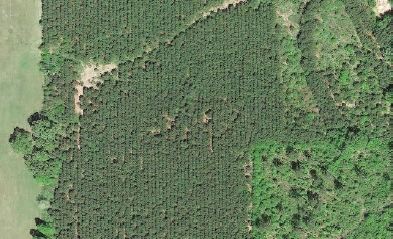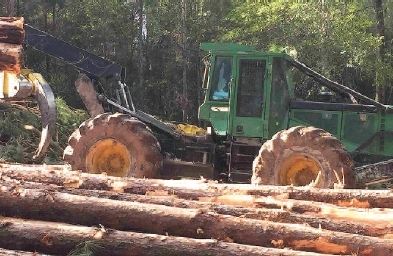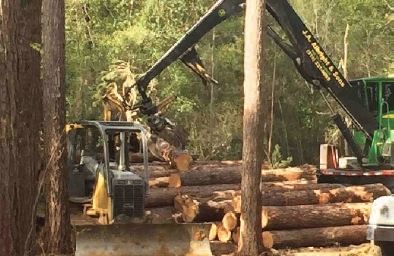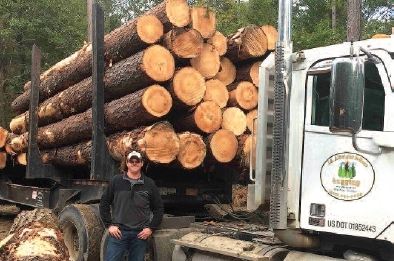The Pine Tree, You, and Me
by Ryan Chappell
 Here in the south, we grow a lot of plants. Some are good, some are not. If you were to ask people somewhat familiar with Louisiana, which is where I live, what the largest agricultural crop is, you would probably hear cotton, sugar cane, and maybe rice. None of those are correct. The largest agricultural crop in Louisiana is trees, including hardwoods, such as oaks, and softwoods, like the pine tree. We grow a lot of trees.
Here in the south, we grow a lot of plants. Some are good, some are not. If you were to ask people somewhat familiar with Louisiana, which is where I live, what the largest agricultural crop is, you would probably hear cotton, sugar cane, and maybe rice. None of those are correct. The largest agricultural crop in Louisiana is trees, including hardwoods, such as oaks, and softwoods, like the pine tree. We grow a lot of trees.
My family and I farm a few hundred acres of pines in Northern Louisiana. We use the land to hunt and just enjoy being out in the woods. I’ve also been fortunate enough to have been a part of planting and harvesting the trees. It is interesting to see the changes in the land as these cycles proceed.
The life cycle of a tree is between 25 to 30 years. The first cutting is done after 10 to 12 years, another one about 16 to 18, and the final cutting is known as a clear cut, where all the pines are removed. Trees are harvested just like corn, soybeans, cotton, and wheat. Those crops have a one-year rotation, but trees go out longer. And just like cotton is replanted in the spring, trees are replanted after being clear cut.
Planting a Pine
Have you ever noticed when plying that when you look down on a forest, there seem to be rows of trees? That is because there are rows of trees and those trees were planted. The trees come in packages of 1,000 and are one to two feet in length, including the root. The pines are planted in late winter, when it’s cold enough and wet enough to make you miserable during your effort. The ground will have some bushes, stumps, and limbs to trip or climb over. How nice they look in a row from the air!
 An aerial view of pine trees planted in rows.
An aerial view of pine trees planted in rows.The process begins with the person planting, who uses what is known as a dibble, a steel tool with a triangular or square blade on the end and handle on the other. The planter inserts the blade into the ground, then moves the handle forward and backward to expand the hole. He then places the seedling into the ground.
And here is a key part: the planter inserts the seedling into the ground as far as possible, and then pulls it out a little. This is to keep the tender and pliable roots of the seedling as straight as possible in the hole. If the planter just pushes the seedling in and does not pull it back some the root system will “J root.” This means the bottom of the root is pointing toward the surface. This does not allow for proper growth. The planter then inserts the dibble into the ground and pulls back on the handle to push dirt around the roots and then pushes it forward to cover as much on the middle part of the seedling as possible. He walks 10 feet and does it again.
The Harvest
 The skidder moves the logs out of the woods to the set, where they can be delimbed, cut to size, sorted, and loaded.
The skidder moves the logs out of the woods to the set, where they can be delimbed, cut to size, sorted, and loaded.Tree harvesting is very mechanical now. In the past, loggers would carry chainsaws and cut down and limb up to the trees, which is very hard work. Today, mechanical harvesters are used. The machine drives up to the tree and places hydraulically operated clamps around the tree. There is a blade, server feel in diameter, that goes into the tree and cuts it off as low as possible in seconds. The mechanical arms then place the trees on the ground and pile them up. A skidder will come along and place hydraulically operated tongs around the piles and pull the trees to a “set.” This is an opening in the woods where the wood is accumulated. There is an opening in the woods where the wood is accumulated. There, a machine picks up each tree and delimbs it and cuts it to a certain length. The trees are then loaded on a truck and carried to the mill. Each truck carries about 28 tons.
Just as a corn farmer will plow the residuals left from harvesting back into the field, so it is done in tree harvesting. All the limbs and other material from the trees not carried to the mills are left in the forest. Planting trees is sustainable; they will break down and return nutrients to the soil for the next generation of trees.
But wait, there’s more.
 The trees are delimbed and cut to the proper size.
The trees are delimbed and cut to the proper size.It takes two tons of trees to produce one ton of paper. Looking at the yearly production of the mills in Louisiana, 5,500,000 that would be almost 11,000,000 tons of trees. Sure, some of the material used is recycled paper grades such as OCC, DLK and some bleached. Let’s estimate 15 percent of the production uses recycled paper. Remember, in order to be called virgin paperboard, the new fiber content needs to be at least 80 percent. This will drop the virgin fiber input to 4,675,000 tons and the mill will need 9,350,000 tons of trees per year. Figuring 28 tons of trees to the truck, that’s 334,000 truckloads per year.
A log truck gets about four miles to the gallon. Let’s say the average round trip from the logging operation to the mill is 80 miles. That’s 20 gallons of diesel. Let’s say the average load carried is 28 tons. Using our figure of 334,000 truckloads per year, at 20 gallons per round trip, that is 6,680,000 gallons of diesel per year, just for the trucks. And we have not yet moved one ton of roll stock from the mill to the end user.
Nothing is Wasted
Some might say that’s a lot of waste, but they would be wrong. The mills wring every drop of good out of the tree. Nothing is wasted. The trees are “debarked” and the bark is used as a fuel source in the boilers. The tree is then “chipped” for the pulping operation. The chips are placed into continuous process digesters and using sodium hydroxide, heat and time, the natural glue that holds the chip together, lignin, is dissolved into the pulping chemicals. The chips are then washed, and the pulping chemicals are removed.
 A load of logs ready to go to the mill. This load will be cut into lumber, such as 2x4s.
A load of logs ready to go to the mill. This load will be cut into lumber, such as 2x4s.Don’t worry about the water used to wash the chips, it’s recycled in the multi-stage washing process. This concentrated water with the pulping chemicals goes through an evaporator to remove the water, using heat from burning the bark. This material is a high content of the natural glues and resins of the pine trees. It is very high in BTUs. (Think about the lighter pine used to start the fireplace or campfire.) Then the concentrated pulping chemicals are sprayed into a recovery boiler. The heat liberates the sodium, which is then used to make sodium hydroxide. The steam generated by the heat is used in various places in the mill.
Many years ago, mills used Batch Digesters and when the chips were cooked, the pulping chemicals were dumped. But they soon learned that was expensive and not the right thing to do. In a paper mill, nothing is wasted. Paper mills were recycling long before it was popular.
More Than Just Trees
Paper rolls are made to order. When they come off the machine, they have to be shipped, as most mills don’t have a lot of warehouse space. So now we need to move 5,500,000 tons of paper to get to the end user. At 50 tons per rail car, that’s 110,000 rail cars. Most trains have about 100 cars, so that is 1,100 full-length trains per year, more than three a day.
Production of Paper Mills in Louisiana | ||
|---|---|---|
|
Mill |
TPD |
TPY |
| WestRock - Hodge | 2,500 | 875,000 |
| Graphic – W. Monroe | 2,500 | 900,000 |
| IP – Campi | 2,000 | 700,000 |
| IP – Mansfield | 4,500 | 1,575,000 |
| PCA – Deridder | 1,000 | 355,000 |
| Hood – St, Francisville | 850 | 300,000 |
| GP – Port Hudson | 2,300 | 800,000 |
|
Total |
15,700 |
5,500,000 |
Take whatever percentage you want of the 5,500,000 tons and put it into a truck. If 100 percent is moved by truck, at 21 tons per truck, that equates to 261,900 trucks or seagoing containers per year, or 750 trucks per day. And this is just for Louisiana. The scale and size of the entire process are enormous. And it all begins with a single pine tree planted as a seedling. As the pines grow, they provide wildlife habitat, shade, and beauty, in addition to being the raw material that makes our lives better through paper, fuel, lumber and many other products. The cycle of the pine tree is sustainable, now and into the future. Forest owners in Louisiana are proud of their lands, and my bet is that timber continues to be the largest agricultural crop in our state for a long time to come.
Hopefully, forest owners continue to use BMP, or Best Management Practices. This means taking care of the land. One way is by not cutting within a certain distance of a stream or creek to avoid erosion. This allows the forest to do what it does best: take in carbon dioxide and make oxygen for us.
To me, the land we own is more than an investment to grow trees. It is something tangible; you can walk on it, see the trees and the wildlife, smell it. That smell changes with the seasons and I enjoy walking in the woods every season of the year. One of my favorite times is when it is cold and there is a light rain or mist in the air. No scented Christmas candle comes close.
Our forest is a place to relax and escape the day-to-day thoughts of work, to simply sit and be quiet. All it asks from us is to help take care of it as we would any living creature.
Return to News

